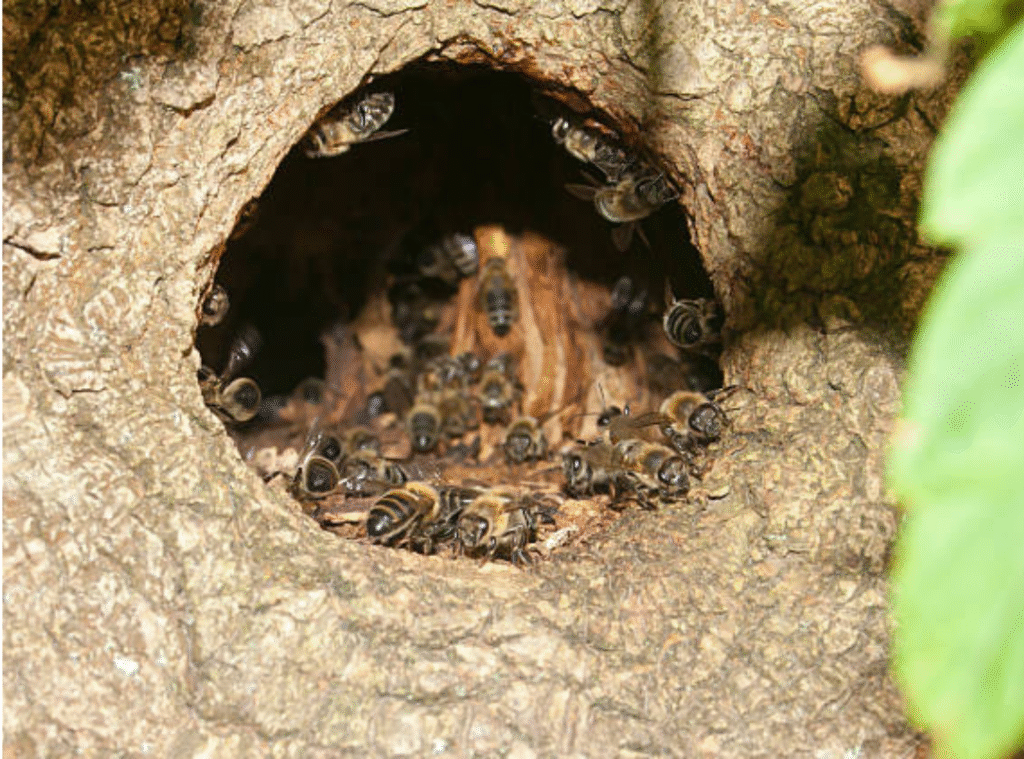Encountering bees in a hollow tree trunk can be a surprise, especially if the tree is in your backyard or close to human activity. These locations provide ideal shelter for bee colonies, protected, shaded, and often undisturbed. While bees play an essential role in pollination and ecological balance, having them this close to home can raise safety concerns for children, pets, and those with allergies. Rather than rushing to remove them yourself, it’s crucial to approach the situation strategically and with care. This article will guide you through the safe, effective, and humane ways to handle bees in hollow trees.
Why Bees Choose Hollow Trees as Nests
Before deciding how to handle bees in hollow spaces, it’s important to understand why they’re there. Hollow tree trunks offer natural insulation, protection from predators, and space to build their hive. The enclosed environment shields them from wind, rain, and temperature fluctuations. In many cases, bees will choose older or decaying trees because the internal cavities make hive-building easier. These locations are not random; they are a product of bees’ evolutionary preference for safe, sustainable nesting sites. Understanding this natural behavior can help you respond more effectively and with less stress.
Identifying the Signs of Bees in Hollow Trees
Spotting a hive isn’t always immediate. Sometimes, the only visible clue of bees in hollow trees is the steady flight of bees in and out of a trunk crevice. Listen closely, you may hear a low hum or buzzing sound coming from within the tree. On warm days, you might even notice increased bee activity, particularly around the trunk’s opening. While some people mistake this behavior for temporary foraging, persistent traffic indicates a colony has taken residence. If you spot honeycomb residue or wax buildup near the entry point, it confirms the bees have built an internal hive.
Risks of DIY Removal and Why It’s a Bad Idea
Handling bees in hollow trees on your own is dangerous and often ineffective. Tree cavities can house large colonies with thousands of bees. Any disruption may provoke defensive behavior, putting you at risk of stings, especially if you’re allergic. Moreover, traditional pest control sprays or foams are not only inhumane but also ineffective long-term, as they fail to reach the deep inner chambers of the tree. If you’re facing an active hive, it’s best to consult experienced bee removal specialists in San Diego County who can safely extract the colony and relocate it without harming the tree or the bees.
Safe and Humane Options for Bee Removal
For homeowners and property managers, the ideal solution is always humane removal. Professional beekeepers use techniques like thermal imaging to locate the hive’s exact placement within the trunk. Once mapped, they may employ specialized suction tools or open a small, controlled section of the tree to reach the hive without harming the colony. These methods not only protect the bees but also preserve the tree’s structural integrity. Humane relocation ensures bees are transferred to a safe environment, often to farms or apiaries where they can continue pollinating vital crops and ecosystems.
Preventing Bees from Returning to Hollow Tree Trunks
Once the hive is safely removed, it’s critical to prevent new colonies from moving in. Bees in hollow trees are more likely to return to previous nesting sites if the entry points remain open. Professionals will usually recommend sealing the hollow area with breathable but secure materials, like steel mesh or expandable foam. It’s also helpful to prune nearby flowering plants or trees, especially if they’re known to attract pollinators. While prevention won’t guarantee complete avoidance, it significantly reduces the likelihood of reinfestation in the same tree trunk.
Managing Bees in Public Spaces or Urban Areas
Dealing with bees in hollow trees becomes more complex when located in urban parks, sidewalks, or schoolyards. In such cases, timing is crucial. Coordinating removal during early morning or late evening hours when bee activity is lowest can reduce safety risks. Public authorities or city planners should work closely with certified removal experts who understand the legal and environmental considerations involved. Bees in hollow trees located in populated areas demand careful communication, safety protocols, and often, public notification to ensure community awareness and protection.
Long-Term Coexistence and Bee Education
While immediate removal might be necessary in some cases, it’s worth exploring long-term coexistence options when safety isn’t compromised. Bees in hollow trees far from human foot traffic can often be left undisturbed. Landowners may choose to label trees as protected or educational markers, turning them into opportunities for community learning. Raising awareness about the role of wild bee colonies in local biodiversity fosters a more harmonious relationship with nature. With the proper precautions and respect for their space, coexisting with bees becomes less of a challenge and more of a shared benefit.
Conclusion
Dealing with bees in hollow tree trunks requires patience, knowledge, and the right kind of assistance. From early identification to humane removal and future prevention, every step should prioritize safety for people and bees alike. These pollinators are vital to our ecosystems, and their nesting choices, while inconvenient, stem from instinct and survival. Whether you’re a homeowner or managing public land, the key is to act responsibly and avoid hasty, harmful solutions. With help from ethical professionals and a thoughtful approach, it’s entirely possible to solve the problem while supporting nature at the same time.





